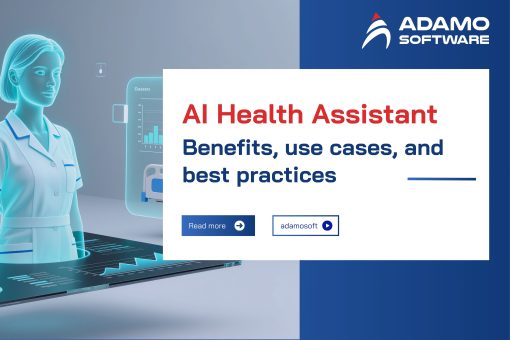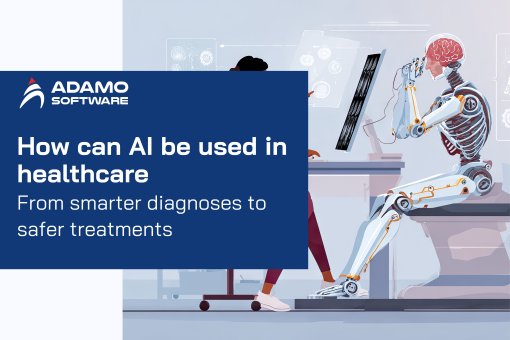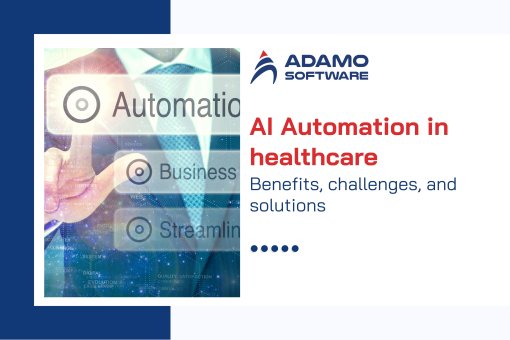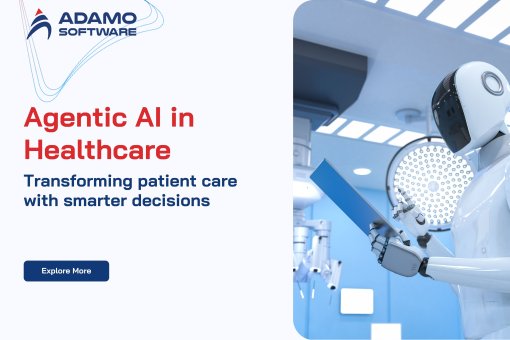Healthcare technology trends: How things changed in 2026 and beyond
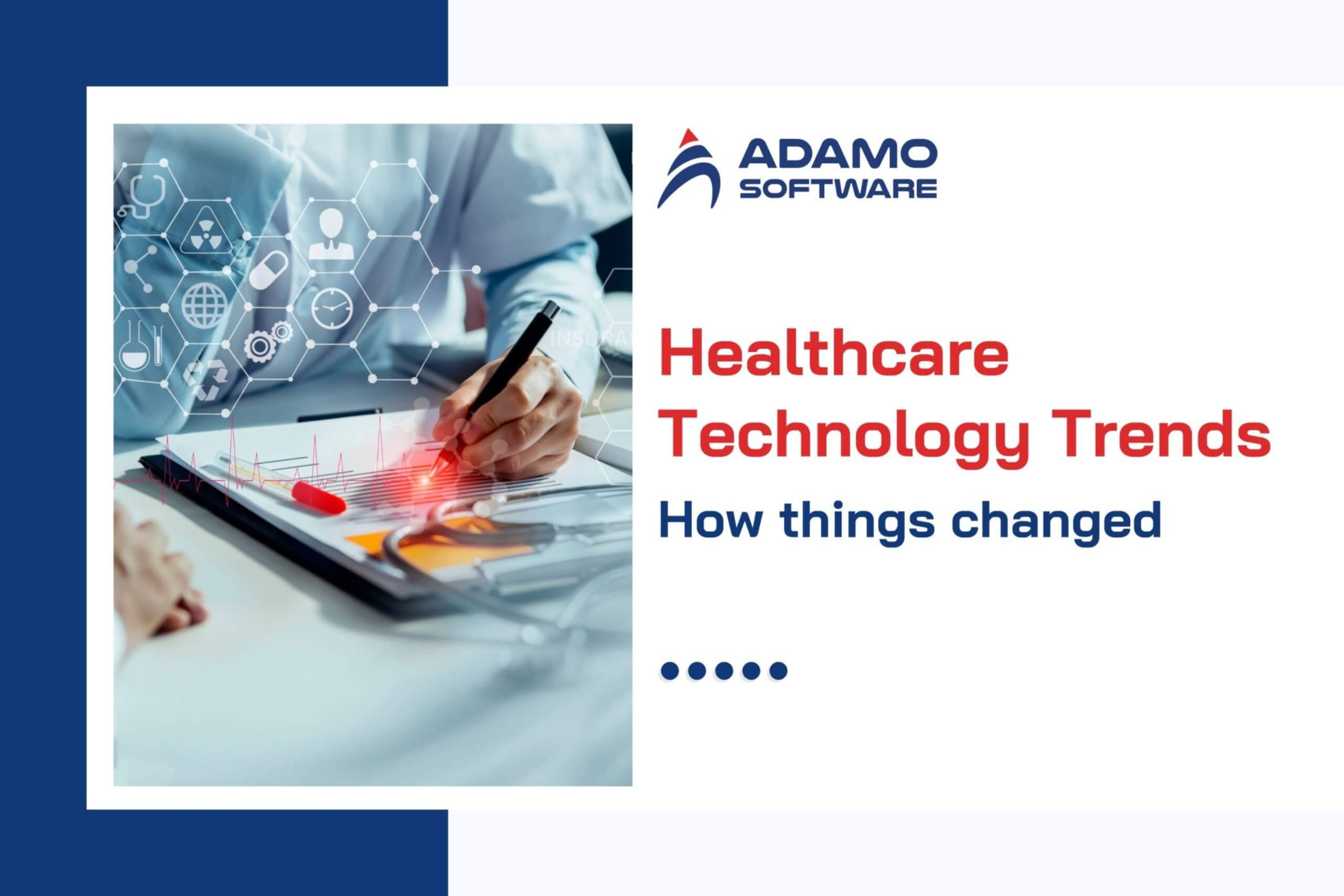
In today’s digital world, many industries have switched to using advanced technology. The healthcare sector is also one of them. Many new technologies can be integrated into healthcare services. They include artificial intelligence (AI), RPA (robotic automation), 3D printing, virtual reality, genomics, telemedicine, etc.
By using these technologies, healthcare facilities can control operating costs, optimize work performance, and enhance the accuracy of treatment and care. The healthcare technology trends have created a significant breakthrough that helps to enhance treatment efficiency and expand access to healthcare services. Let Adamo Software discuss these trends and see how things will be changed in 2026 and beyond.
Through this blog post, you will learn about the definition of healthcare technology and the emerging trends. All information has been thoroughly researched and updated to the latest trends. So, let’s read our post and find some useful information for you!
I. Healthcare technology trends: Definition
Before finding more detailed information about healthcare technology trends, Adamo Software will show the definition of healthcare technology. It is the use of technology in the medical and healthcare fields to treat and provide better services to patients.
Implementing technological advancements in healthcare reduces strain on the medical supply chain and streamlines the examination and treatment process, resulting in time and cost savings for both patients and healthcare institutions. Promoting digital transformation is seen as a solution to improve patient care and build more efficient, streamlined operating processes that meet the needs of healthcare providers, patients, and healthcare-related organizations.
As a result of the healthcare technology trends, doctors and caregivers today can approach healthcare more holistically. Using technology in healthcare also benefits patients when they can be proactive in their health check-ups. Thanks to innovative inventions, from AI and the Internet of Things to remote healthcare platforms, healthcare technology trends can expand access to medicine and promote personalization and security in healthcare. Below are some common features of healthcare technology.
- Focusing on patients
Patients and patient care are the top concerns of doctors and healthcare facilities. Thus, the new technologies used in the healthcare industry must ensure improved experiences, increased safety, and improved treatment efficiency.
- Complex processes and massive data
The healthcare industry handles large volumes of complex patient-related information, from medical records to genetic data. Therefore, no matter what current healthcare technology trends are, the technologies used must be secure, easily accessible, and efficiently analyzed.
- Strict compliance and regulations
Healthcare technologies must comply with strict regulations on data security and privacy. This is to protect patients and maintain public trust in the healthcare system.
- Digitalization and automation trends
Digitalization and automation are rising healthcare technology trends that help the healthcare industry optimize costs. Besides, this contributes to reducing the workload for healthcare professionals and improving process efficiency.
In general, the healthcare technology trends are not only the improvement in technology but also contribute to reshaping the way healthcare is delivered and managed in society. These technologies enhance the accessibility, personalization, and security of health data. These tools have the potential to revolutionize healthcare. They could unlock new treatments and improve patient care on a global scale. This fosters a contemporary, intelligent, and eco-friendly healthcare network.
II. Top 10+ emerging trends in healthcare technology
The emerging healthcare technology trends are driving major changes in the way health services are delivered and managed. Let Adamo Software discuss the top 10+ leading trends that are shaping the future of healthcare and contributing to better quality of care for patients.
1. Artificial Intelligence (AI)
Applying AI to disease examination and treatment is one of the rising healthcare technology trends. Here’s how AI helps in the healthcare industry.

- Analyzing medical images and predicting pathology
The integration of AI-powered deep learning techniques into radiology and diagnostic practices is revolutionizing the field, enabling the rapid analysis of X-rays, MRIs, and CT scans to identify potential disease indicators that may elude human perception, particularly in the context of enhancing breast cancer detection accuracy. Radiologists performing the diagnosis can detect breast cancer with 75.3% accuracy, while with the help of artificial intelligence, the accuracy rate increases from 9.5% to 84.8%.
The timely identification and diagnosis of the illness is crucial in enabling physicians to formulate precise treatment plans, thereby significantly enhancing the probability of patient recovery.
- Automating the medical record management process
AI has become one of the growing healthcare technology trends because of its application in image diagnosis. Besides, it helps automate the medical record management process. AI can help to convert the conversations between doctors and patients into text, and then automatically enter them into the electronic medical record (EHR) system. This reduces manual data entry errors and saves time for medical staff.
Besides this, AI uses algorithms to sort, classify, and analyze information from medical records. It can analyze symptoms, and medical history, and recommend appropriate treatments, helping doctors quickly access the necessary information. In addition, AI can automatically mark and classify medical records according to priority, helping medical staff quickly identify urgent cases.
In general, by automating the medical record management process, AI reduces manual workload, increases efficiency and accuracy in medical record management, and allows healthcare professionals to focus more on patient care.
In addition to helping to analyze medical images and automate processes, AI is also applied to secure information between doctors and patients as well as medical records. AI also helps personalize treatment regimens, analyzing patient genetic and lifestyle data to recommend optimal treatment.
2. Augmented Reality & Virtual Reality
Augmented reality (AR) and virtual reality (VR) are emerging healthcare technology trends that help to improve medical training, assist in surgeries, and enhance the patient’s experience. Let’s see how each technology helps with Adamo Software!
- Virtual Reality
As one of the healthcare technology trends that is becoming popular in healthcare facilities, VR is applied to train medical staff. It provides a realistic simulation environment that allows medical students and interns to perform complex surgeries or learn clinical skills without putting real patients at risk. With VR, they can directly interact with medical models, observe body parts from all angles, and practice medical techniques safely and effectively.

Besides helping doctors and medical students, VR also benefits patients. VR technology is an attractive solution to help patients relax and reduce pain. Vivid images from virtual reality systems can be used as a distraction instead of pain medication. This therapy is especially applicable to patients who are allergic to pain medication or have overdosed on pain medication.
VR can help doctors explain treatments more simply and easily to patients. This technology can project an image of a tumor or a part of the human body that needs surgery to make it easier for the patient to visualize.
- Augmented reality
AR technology allows doctors to see medical information right on the patient’s image in real-time. For example, when performing surgery, doctors can use AR to see the anatomical structure layer below the skin surface without having to cut and cut, thereby increasing accuracy and reducing risk. The AR can be used to scan an image of a human skeleton and see the details of each part. Besides, doctors can use it to get information about the symptoms, causes, and treatments of the patient’s condition.
Overall, both AR and VR are surging healthcare technology trends that help to change the way healthcare is delivered and experienced, improving the quality of treatment and expanding training possibilities in the medical industry.
3. Big data and analytics

Big data and analytics have become an indispensable part of the healthcare technology trends that help the medical industry examine information from massive amounts of data to improve the quality of healthcare.
Thanks to big data and analytics, healthcare facilities can track and analyze patient records, medical histories, genetic data, and patient lifestyle to create personalized treatment plans.
Besides, medical care facilities can cut costs, minimize errors, ensure the best care services, and provide early diagnosis for patients. Let’s find more detailed information about the benefits of big data and analytics in the healthcare industry.
- Improving diagnosis’s accuracy
Traditional diagnostic methods can sometimes miss important details due to the lack of information. Big data analytics can solve this problem. By processing and analyzing large amounts of data, big data can lead to earlier and more accurate diagnoses. Early diagnosis and treatment can improve patient outcomes.
- Personalizing treatment plans
Big data can help personalize treatment plans. Different patients have different needs, lifestyles, genetics, and medical histories. Besides, they also respond to drugs differently. By analyzing vast quantities of patient data, healthcare providers can implement personalized medicine, thereby enhancing treatment efficacy.
- Reducing costs
Reducing costs for operating is also among the benefits of big data in healthcare. Big data helps to cut down the unnecessary costs for staffing and inventory management. Thanks to the prediction of high-risk diseases from big data, costly emergencies, and hospital readmissions can be prevented. Besides, big data also contributes to eliminating redundant tests and procedures.
Overall, big data and analytics are among the outstanding healthcare technology trends that contribute to improving prediction, optimizing treatment and personalizing healthcare for each patient.
4. Blockchain
Among the healthcare industry trends, blockchain is outstanding with its high-security features. This technology is a solution to the data security challenges related to electronic medical records, electronic health records, medical records, treatments, etc.

Below are some benefits of blockchain, one of the increasing healthcare industry trends, to the medical field.
- Actively managing medical records
Instead of users’ medical records being stored on servers of many different hospitals, users are now the main owners of their own medical records. They can store their medical records and insurance records in the same account on the Blockchain platform. Continuously updating health history helps users see the latest and most accurate information at any time.
Simultaneously, it allows healthcare facilities to directly access the latest data to ensure the best care when patients are hospitalized or in an emergency.
- Traceability of pharmaceuticals
Blockchain can be applied to trace the origin of pharmaceuticals, drugs, or medical devices in pharmacy systems. This helps to ensure that drugs are imported from reputable, high-quality suppliers. Besides, this technology also creates data records to manage the distribution and consumption of drugs at medical units and hospitals in a transparent and accurate manner.
- Storing medical examination and treatment information
Blockchain is used in management systems and stores all medical examination and treatment information of the hospital in real-time with high data security. The information includes patients, medical equipment supply chain, and drugs. Only members who own the secret key have access to these pieces of information.
- Data connection in the system
Data on Blockchain is connected between other medical units in the same medical system. It helps doctors to access and view medical records directly and compare them with the original data stored in patient’s phones. This creates favorable conditions for patients to change between other facilities in the system without having to carry their medical records. At the same time, it serves medical research and necessary clinical testing.
In general, blockchain is among the surging healthcare technology trends that play an important role in securing medical data and creating more transparent, secure processes for the healthcare industry.
5. Clean Tech
Clean Tech is one of the most important healthcare technology trends, as healthcare facilities are increasingly concentrating on minimizing environmental impacts and optimizing resources. Clean Tech in the healthcare industry can be applied to save energy in hospitals, treat medical waste effectively, and produce environmentally friendly equipment and pharmaceuticals. Healthcare facilities that adopt Clean Tech can use renewable energy, advanced air filtration technology, and recycling processes, thereby significantly reducing carbon emissions and toxic substances.
Healthcare facilities can use smart technologies to optimize resources, such as automated energy management systems or energy-saving medical devices. Especially, green and recyclable medical materials are increasingly used in hospitals, helping to reduce medical waste and protect the surrounding environment.
Overall, as one of the growing healthcare technology trends, Clean Tech not only aims at patient health but also improves environmental conditions for the community, promoting sustainable and long-term development for the global healthcare system.
6. Cloud computing
Cloud computing is also among the typical healthcare technology trends. Medical facilities gradually turn to cloud computing to save costs, reduce procedure time, and improve medical examination and treatment efficiency. Cloud computing will synchronize medical records, examination, and treatment processes without too many complicated documents. Cloud computing services in the medical field are how medical data is stored, managed, and processed through remote servers via the Internet.
Compared to the traditional approach, there is no need for an on-premises data center on personal computers to store data.
Healthcare facilities can use cloud computing services in many forms, such as electronic medical records, remote medical examination, patient portals, remote monitoring, and connected devices that support the Internet of Things, collecting patient data from various sources and analyzing big data. By enabling on-demand scaling and flexible resource allocation, cloud technology empowers healthcare providers to make data-driven decisions faster and more effectively.
Medical experts are increasingly adopting cloud technology in healthcare because of its benefits. Below are some outstanding advantages of this technology.
- Unlimited storage at a low cost
- Easily analyzing data
- Promoting interoperability
- Enhancing patient experience and satisfaction
- Examining and treating remotely
One of the popular applications of cloud computing is electronic health records (EHRs). Every individual can have a comprehensive digital health record, containing important information such as demographics, medical history, and test results. Also, medical histories and diagnoses are stored in the EHR.
In general, cloud computing is among the essential healthcare technology trends that contribute to supporting healthcare organizations to provide more flexible and reliable healthcare services.
7. Connectivity Technologies
Connectivity technologies, including 5G, Wi-Fi 6, and other advanced networks, are becoming one of the leading healthcare technology trends that enable healthcare facilities to perform telemedicine services. With fast data transmission speeds and low latency, these technologies allow doctors to monitor and consult patients remotely, supporting real-time communication and sharing of accurate medical information. This is especially useful in emergency situations when specialists can coordinate immediately, regardless of geographical distance.
This network plays a crucial role in transmitting and exchanging high-resolution medical images and supporting healthcare initiatives, remote patient monitoring, and a host of other complex AI, VR, and AR features.
In addition, 5G combined with Wi-Fi 6 will be able to help download documents and exchange information between all mobile devices and tablets throughout the hospital system and healthcare facilities much smoother and faster. In short, as one of the growing healthcare technology trends, connectivity technologies are changing the way healthcare is delivered and experienced, helping to expand healthcare access and improve the quality of healthcare globally.
8. Internet of Things
Also, on the list of emerging healthcare technology trends, the Internet of Things (IoTs) has great potential in the healthcare industry. Applications in this field help improve the quality of healthcare, reduce stress for medical professionals, and help patients receive treatment at home without having to go to the hospital. Below are some benefits of the IoT for healthcare facilities.
- Real-time care data management
With the advent of IoT in healthcare, managers can access real-time patient data. There are many applications for healthcare by integrating with wearable devices like Apple Watch and other health monitoring devices; these applications can send real-time patient data to the care manager and the care manager can use this data to create and implement better care management programs for the patients.
- Reducing health costs
The availability of real-time data through wearable devices has made it possible to better monitor patients remotely, doctors and care managers not only provide better care to patients but also help reduce overall healthcare costs. Doctors and care managers can guide patients remotely, without having to meet the patient in person to discuss a particular case. Therefore, IoT has reduced healthcare costs and also helped speed up the delivery of care.
- Analyzing medical data
The use of IoT has also given a positive boost to healthcare analytics. With connected applications in wearable devices, healthcare professionals can access a large amount of data, which helps in analyzing healthcare trends and also in measuring the impact of a particular medication or a particular health condition.
- Reducing medical errors
Reducing errors is a major step towards better healthcare. With IoT, it is possible to integrate accurate data, automate, and make decisions based on analytics. The results of this integration will be more accurate than ever and thus healthcare is moving towards eliminating errors and improving the quality of care.
Overall, IoT is also among the leading healthcare technology trends that help healthcare facilities improve the quality of treatment and manage healthcare more effectively.
9. Advanced Robotics
Advanced robotics is emerging as one of the most influential healthcare technology trends, especially in the fields of surgery, patient care, and rehabilitation support. The role of robots in healthcare, especially in hospitals, is of particular concern regarding the management and control of the spread of disease in hospital environments.
The use of such robots is to minimize human-to-human contact and ensure cleaning, disinfection, and support in hospitals and medical facilities. This will help minimize the life-threatening threats to healthcare workers and doctors who play an active role in managing infections in hospital settings, such as the COVID-19 pandemic. Below is some outstanding robot types used in hospital environments.
- Nurse robots in hospitals
- Ambulance robots
- Telemedicine robots
- Serving robots in hospital
- Spraying/ Disinfestation robots
- Surgical robots
- Radiologist robots
- Rehabilitation robots
In general, advanced robotics not only improves efficiency and accuracy in healthcare but also assists healthcare workers, allowing them to focus more on their professional tasks. As a key player in the healthcare technology trends, robots are helping to shape a modern, flexible, and patient-oriented healthcare system.
10. Biometrics
Biometrics is becoming one of the important healthcare technology trends, especially in identity authentication and enhancing the security of medical data. Biometric technology, including facial recognition, fingerprints, irises, and even voice recognition, helps medical facilities verify the identity of patients and staff more quickly and accurately. This not only ensures high security but also reduces the risk of errors in personal information management, helping to increase trust for both patients and medical institutions.
Biometrics also helps effectively grant access to sensitive medical records, prevent unauthorized access, and protect patient personal data. For telehealth services, biometrics help authenticate patients and protect privacy throughout the examination and treatment process.
Overall, as one of the advanced healthcare technology trends, biometrics not only brings high security but also creates convenience and safety for the healthcare system, thereby improving the quality of healthcare and increasing patient confidence.
11. Digital therapeutics
Digital therapeutics is also among the key healthcare technology trends. It delivers medical interventions directly to patients using evidence-based, clinically evaluated software to treat, manage, and prevent a range of diseases and disorders. Digital therapeutics uses software to deliver clinical data-driven therapies to change behavior, improve mental health, and support patients with chronic conditions such as diabetes, obesity, or cardiovascular disease.
These therapies are often personalized and can monitor the patient’s condition in real-time, allowing for dynamic adjustments to treatment.
Besides, digital therapeutics also play an important role in psychological treatment and mental health improvement. Apps and therapy programs can help patients monitor, manage stress, and reduce anxiety. These tools are often developed based on scientific research, provide high treatment efficiency, and help patients access therapy easily and conveniently from a distance.
In short, digital therapeutics helps doctors monitor the effectiveness of therapy, providing accurate data to adjust the regimen promptly. As one of the promising healthcare technology trends, it is contributing to shaping the modern healthcare model, increasing medical access, and improving the quality of life for patients.
12. Wearable health technology

Wearable health technology is one of the advanced healthcare technology trends that helps to monitor and manage personal health. Wearable devices such as smart watches, health bands and body-mounted sensors are increasingly popular, allowing the monitoring of health indicators such as heart rate, blood pressure, sleep quality, calories consumed and activity level. Through the data collected from these devices, users can receive detailed analysis, support the development of healthy habits and early detection of abnormalities.
This technology is also important in chronic disease management. For patients with conditions such as diabetes, high blood pressure or cardiovascular disease, wearable devices help monitor health indicators continuously, thereby allowing timely adjustments to treatment regimens. Data from these devices can be shared directly with doctors, giving them a more comprehensive view of the patient’s condition, thereby improving treatment effectiveness.
In addition, wearable health technology also supports community health care programs, helping medical facilities collect health data of large populations, thereby identifying community health trends and suggesting preventive measures.
In general, as one of the important healthcare technology trends, wearable health technology not only improves the quality of life of users but also expands the ability to monitor health remotely. This helps the health system better respond to the needs of personalized and proactive health care.
You can explore more about “Outsourcing Healthcare Software Development: When it works” here.
13. Value-based care
Value-based care is one of the important healthcare technology trends, focusing on improving the quality of care and increasing medical value instead of just relying on the number of services provided. This technology prioritizes the quality of treatment and long-term health outcomes of patients, incentivizing healthcare providers to provide personalized therapy and care, aiming to achieve the best outcomes at a reasonable cost.
In this model, healthcare facilities use data and advanced technologies such as Big Data, IoT and AI to monitor and measure treatment outcomes, and support accurate medical decisions. This helps patients receive better medical care and minimize unnecessary interventions, while helping the healthcare system use resources more efficiently.
Value-Based Care also promotes prevention and early management of chronic disease, thereby reducing long-term treatment costs. Patients are also involved in their own health care, thereby improving satisfaction and engagement with treatment.
III. How Adamo Software can streamline your healthcare software development journey
In the context of rapidly developing healthcare technology trends, Adamo Software can bring comprehensive and professional solutions for your medical software development. As one of Vietnam’s leading healthcare software development company with extensive experience in designing and implementing modern medical applications, we can simplify the development process from concept to deployment, ensuring that all technology requirements and security standards are met. Here’s how we can streamline your healthcare software development journey.

- Consulting and analyzing requirements
Adamo helps you understand the latest healthcare technology trends and project requirements. Then, the consulting team will work with you to build a solution that fits your organization’s healthcare needs and strategy.
- Developing customized software
Adamo Software is capable of developing custom solutions based on trends such as AI, Big Data, Blockchain, IoT, and Digital Therapeutics. This ensures that your software will have advanced features, meeting the specific needs of the healthcare industry.
- Ensuring compliance with security and data management
We have an understanding of standards such as HIPAA and GDP. Therefore, we can ensure that your software is not only cutting-edge but also meets all security regulations, protecting sensitive patient medical data.
Still hesitating whether to choose Adamo Software for your healthcare software development? Let’s contact us for more detailed information and plans.







